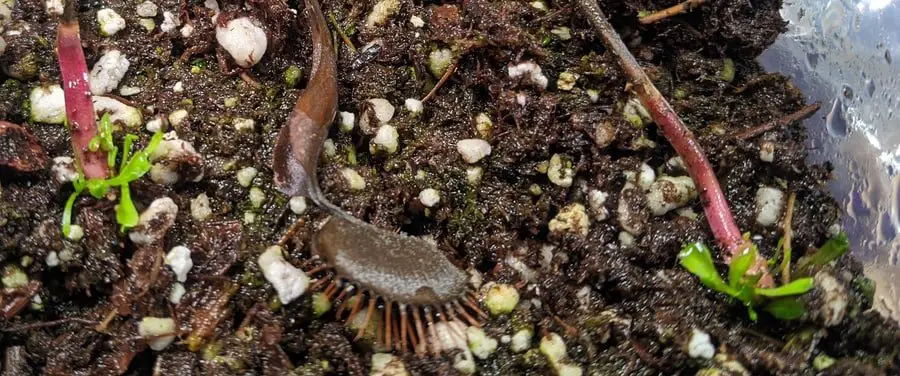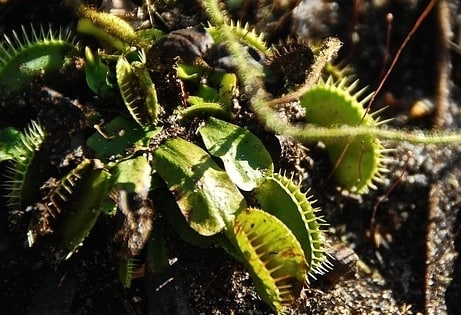A vital care consideration for Venus flytraps is their dormancy period. Dormancy comes naturally for wild Venus flytraps, but at home, many growers wonder if skipping dormancy is a suitable approach.
Venus flytraps should not skip dormancy, as they need it to grow. Cutting dormancy 2 to 3 years in a row usually causes the plant to perish. Still, skipping dormancy in particular circumstances such as growing seedlings is a common practice.
In this article, I will cover all you need to know about skipping dormancy. I will give you specific examples of when you can skip dormancy.
Is Skipping Venus Fly Trap Dormancy an Option?
Wild Venus flytraps are exposed to cold winter weather. During that time, they experience dormancy. Dormancy is essential for the plant’s development.
Venus flytraps achieve dormancy after been exposed to temperatures below 45 F (7 C) for several weeks. Then, they must remain in cold weather for 2-3 months. In the spring, as temperatures start to rise, Venus flytraps exit dormancy.
Venus flytrap dormancy is an essential process that allows the plant to rest and remain strong in the growing season. Optimally, Venus flytraps should go dormant every year. But, for growers, it is not always possible to provide an appropriate environment for dormancy. In those cases, Venus flytrap owners often consider skipping dormancy regardless of the negative effects.
When Venus flytraps skip dormancy, their growth becomes stagnant compared to other Venus flytraps growing rapidly after dormancy (here is more information about each growth stage). Without dormancy, Venus flytraps are also less likely to propagate. Venus flytraps that skip 2-3 yearly dormancy periods in a row weaken and eventually die.
Skipping dormancy is never recommended, as the plant experiences many harmful effects due to the lack of dormancy. The most dangerous side effect is the deaf of the plant. Fortunately, the plant will only die if it skips several consecutive dormancy periods.
Venus flytraps can skip dormancy as long as it is not a recurring practice. The plant will exhibit a slow growth rate but will eventually recover as it goes dormant in the years to come.
Skipping dormancy is a suitable choice in some specific circumstances, such as:
- When growing seedlings or leaf cuttings/ pullings
- When you just got a new plant
- When you are a short-term Venus flytrap owner
The following sections explain in detail each of the scenarios.
Growing Venus Flytraps Seedlings
In their natural habitat, Venus flytraps go dormant when they are seedlings or baby Venus flytraps. Seedlings can definitely go dormant in the appropriate climate. But, at their young age, it is possible to skip dormancy for the first year.
When you grow Venus flytraps seedlings, they are incredibly delicate. Caring for them is a difficult task. If you do not have much experience growing Venus flytraps and with the dormancy process, I recommend skipping dormancy for the first year.
In the case of leaf pullings and leaf cuttings, I have the same advice. Venus flytraps growing from leaf pullings grow quicker than Venus flytraps growing from seeds, but they are still tiny during the first year.
It is safe to skip the first year dormancy for Venus flytrap seedlings or leaf pullings. The plants will develop properly as long as they experience dormancy during the second year and continue to undergo a yearly dormancy.

New Venus Flytrap Plant
Some vendors indicate when was the last time a Venus flytrap went dormant. Then, when you buy the plant, you can determine if the plant should go dormant this year or not. Venus flytraps only require one dormancy period a year. If the plant already went through dormancy, it does not need another dormancy that same year.
In some other cases, Venus flytrap owners are not so lucky. When you do not have any information about your plant’s previous dormancy, it is hard to decide. Generally. I suggest one of these two approaches:
- Make your plant go dormant if you have had it for a few months (3-4) and it has acclimated to the new environment.
- Skip this dormancy period if the plant is still getting adjusted.
Dormancy won’t harm your plant if it is healthy, but weak Venus flytraps can die of shock due to the changes in the environment.
In the case you decide to skip dormancy, remember you need to make sure your plant experiences dormancy the following year (more tips below).
Short-Term Owner
It is estimated that Venus flytraps can live for more than 20 years. When plants experience a traditional growth cycle, they can live an extensive life. However, when Venus flytraps skip dormancy consistently, their lifespan shortens substantially.
Sometimes Venus flytrap owners decide to skip dormancy due to its difficulty. You can employ many methods to make your plant go dormant, but the easiest is to place the plant outside. However, the method is not effective without a cold winter.
Depending on your location, you can consider skipping dormancy if you are not planning to keep the plant for more than 2-3 years. Missing dormancy will kill the plant eventually, but in some circumstances, it is the only choice.
Is a Short Dormancy Acceptable for Venus Flytraps?
Optimally, Venus flytraps should go dormant for 2-3 months to experience the benefits of dormancy. However, such a long dormancy is not always possible. Some locations experience cold winter, but they only last a few weeks or barely two months.
There is no exact science of how long Venus flytrap dormancy needs to be. There is common knowledge that dormancy should take at least 2-3 months. In their natural habitat (North Carolina and South Carolina), Venus flytraps commonly experience more than 3-4 months of temperatures below 50 F.
The safest method to make your Venus flytraps go dormant is to place them outside in cold weather. Venus flytraps can experience full dormancy as long as they are exposed to cold temperatures for at least two months and a half (it takes a few weeks for the plant to enter dormancy).
Venus flytraps growing in locations with extremely short or non-existent winters should undergo dormancy with an alternate method: refrigerator dormancy.
Methods to Achieve Venus Flytrap Dormancy
There are two main methods to make your Venus flytrap go dormant: place them outside in cold winter weather or place them in the fridge for a few months.
The first option is the safest and easiest if you live in a suitable location. Venus flytraps need to be exposed to temperatures below 45 F (7 C) for 3-4 months to complete a full dormancy. When the plants undergo dormancy, they exhibit significant changes. They lose leaves and shrink in size to go into a hibernation state. During dormancy, Venus flytraps need slightly different care considerations.
- Temperature: Plants should remain at the following temperature range: 32F – 45F.
- Feeding: There is no need to feed Venus flytraps during dormancy.
- Lighting: The lighting requirements decrease. Still, it is not harmful to provide lighting.
- Trimming: Trim dead leaves when necessary.
- Repotting: Repotting at the end of dormancy is a common and useful practice.
- Watering: Venus flytraps need less water during dormancy
Make sure to learn about Venus flytrap care and dormancy ahead of time. This article gives covers all about growing Venus flytraps, including dormancy. Make sure to read it and download the free care sheet.
Refrigerator dormancy is more challenging as it has a higher probability of failure and requires a methodic approach. The video below explains the whole process.
Can Venus Flytraps Achieve Dormancy Indoors?
Venus flytraps can achieve dormancy only when exposed to cold weather. They won’t experience dormancy indoors if the environment is heated. However, some cold indoor locations are suitable for hibernation.
Venus flytraps can go dormant indoors in cold garages, basements, or a porch. Unheated locations with temperatures below 45 F are appropriate. Also, refrigerator dormancy is an alternate option.
For more information on growing Venus flytraps indoors, make sure to read this Guide. It covers all the care considerations for Venus flytraps growing indoors. In most cases, it is a challenge to grow Venus flytraps indoors, but it is completely possible to grow healthy plants. The Guide will help you succeed.


